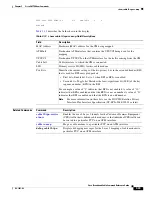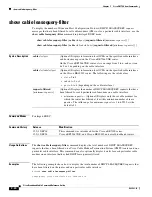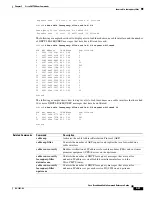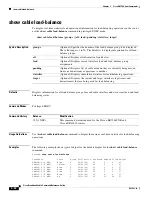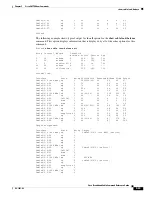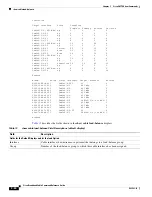
3-53
Cisco Broadband Cable Command Reference Guide
OL-1581-08
Chapter 3 Cisco CMTS Show Commands
show cable modem
Usage Guidelines
This command displays information for all CMs, for all CMs attached to a specific CMTS cable
interface, or for a particular CM, identified by its IP address or MAC address. The output is sorted by
the cable interface and the CM MAC address.
Tip
Several options in the
show cable modem
command do not pause the screen to display the information
page by page, even if the
terminal length
command has been used to set the page size of your terminal.
Paging and pausing the display could result in outdated or stale information for CMs, and thus produce
an incorrect snapshot of the system’s current CM state. To capture or review this information, use your
terminal program’s capture buffer to save the information to a file, and then review it offline.
12.0(7)XR and
12.1(1a)T1
The output of this command was enhanced to show that the Cisco CMTS
has detected an unstable return path for a particular CM and has
compensated with a power adjustment. An asterisk (*) appears in the power
adjustment field for a modem when a power adjustment has been made; an
exclamation point (!) appears when the CM has reached its maximum power
transmit level and cannot increase its power level further.
12.1(4)CX and
12.2(4)BC1
Support was added for the Cisco uBR10012 router.
12.1(10)EC1
Adds an exclamation point to CMs that have exceeded the maximum
delay/timing offset specified by the
cable map-advance
command.
12.1(11b)EC1,
12.2(8)BC2
The output for the Online State field was updated for the
cable tftp-enforce
command. A pound sign (#) appears next to the state value when a CM was
allowed to come online without attempting to download a DOCSIS
configuration file through the cable interface with the Cisco CMTS.
12.2(15)BC1
Additional lines were added to the
show cable modem verbose
displays,
for one or all cable modems, to show information about the dynamic shared-
secret feature. Cable modems that fail the dynamic secret authentication
checks and then come online are marked with an exclamation point (!), so
that this situation can be investigated.
12.2(15)CX The
verbose
option displays the sysDescr field for each cable modem, when
the
cable modem remote-query
command has been configured. Other
fields have also been added to support DOCSIS 2.0 (ATDMA) operation.
12.2(15)BC1c The
verbose
option displays whether dynamic service change requests
(DSX) are allowed from cable modems.
12.2(15)BC2
Two new states—cc(r1) and cc(r2)—have been added to the CM MAC state
field (see
Table 3-15
) to indicate the CM status when it has been instructed
to change channels and is ranging to obtain a new downstream or upstream
channel.
Also, three new states—online(pkd), online(ptd), and expire(pkd)—were
added to clarify the BPI state when network access has been disabled in the
CM’s DOCSIS configuration file.
In addition, the
show cable modem verbose
command now displays the
total amount of time that a CM has been online since last registering.
12.1(20)EC1
The three new states—online(pkd), online(ptd), and expire(pkd)—were
added to the Cisco IOS Release 12.1 EC train.
Release
Modification

